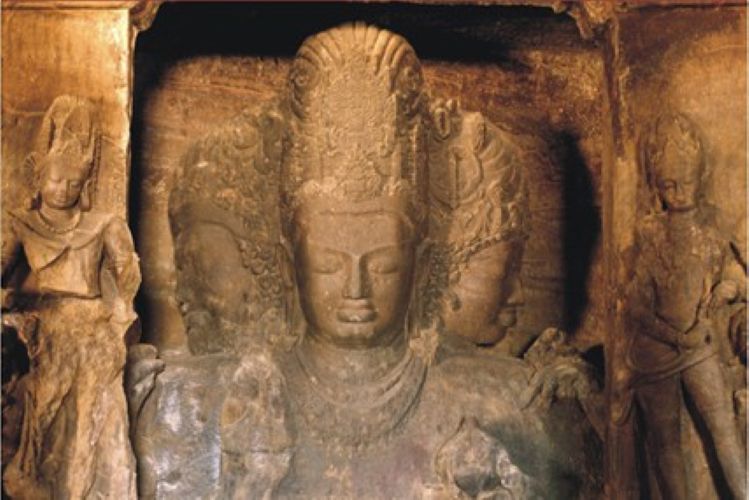5,000 YEARS OF SCULPTURE

Benoy K Behl
The history of Indian sculpture is the story of one of the oldest cultures of the world, which continues till today.
Five thousand years ago, there was a vast civilisation established in the river valleys of North India. The first sites found were in the basin of the Indus river. All art found is made on a small scale and is very sophisticated. Unlike other cultures, in the thousands of art objects found here, there are no images of warfare or prisoners.
Upanishadic Vision
In the beginning of the First Millennium BCE, the Upanishads were composed in the Indian sub-continent. These were based upon continuing philosophic traditions of the land. The ideas expressed here are basic to all Indic philosophies. Indian art is filled with the Upanishadic vision. In this view, the material world around us is seen to be an illusion, based upon our perceptions. The high purpose in life and of art is to lift the veils of this illusion and to look beyond.
In the 3rd century BCE, Emperor Ashoka erected several large pillars and inscribed his edicts upon rocks. In keeping with ancient traditions, the inscriptions show that the emperor was preoccupied with ‘Dharma’. Dharma means one’s duty to the whole of existence.
Images of ‘yakshas’ and ‘yakshis’ represent the protection of nature and its great fertility. This ensures the continuance of life. The Buddha himself is never made in this early Buddhist art. Instead, there are symbols which indicate his presence.
Over a thousand years, from the 2nd century BCE onwards, over 1200 caves were excavated from Western Ghats mountains. Individual sculptures and pillars were donated by merchants, bankers, gardeners, farmers, fishermen, housewives, including Greek devotees.
Jaina Rock-Cut Caves
In the meantime, in the 2nd and 1st centuries BCE, Jaina rock-cut caves and stupas were made in many parts of India. These show the close similarity of art as well as that of the symbols of the Buddhist and Jaina faiths.
The Kushanas ruled from the 1st to the 3rd centuries CE. In this period, there was a new focus on the depiction of personalities in art. Images of Buddhas Bodhisattvas, Jaina tirthankaras, and Hindu deities were created in the Mathura region. These followed the earlier models of the Yakshas and Nagas.
The early Buddhist site of Amravati is on the bank of the river Krishna, in the present day state of Andhra Pradesh. In the 2nd century CE, the sculptural reliefs of the magnificent stupa reached their culminating phase. This was done under the Satavahanas. Hence was created a world of Buddhist narratives.
In the 1st century, deities in human form had been created in Indian art. This was done to provide a support to mind not prepared to comprehend the formless abstract. The human form had to be created, which rose above itself. It was an embodiment of that which was eternal. Undisturbed by turmoil and cravings. Meditating upon such a form, devotees awakened the best within themselves.
In the first quarter of the 5th century, 20 rock cut caves were carved out of the hill at Udaigiri, near Sanchi. These are the earliest surviving Hindu temples. The most magnificent representation here is of the Nara-Varaha avatara of Vishnu.
Wondrous Hindu Excavation
The most wondrous Hindu excavation of the 6th century is on Gharapuri Island in Mumbai harbour. The island is popularly known as Elephanta.
On the south wall of the cave is made a profoundly moving representation of Lord Shiva. The image emerges from a dark void, as a vision of the unmanifest eternal.
It is in the Virupaksha temple of the 8th century at Pattadakkal that we encounter the full glory of art under the Early Chalukyas.
This vitality and movement is seen in 8th century art across many parts of India, including Tamil Nadu, Rajasthan and Orissa.
On the shores of Tamil Nadu, is Mamallapuram, a marvellous town of temples, carved out of the rock.
Here, a granite hill face, almost 100 feet by 50 feet, has been transformed into a world of divine and earthly beings. This giant relief is of the 7th century.
Magnificent Depiction
One of the most magnificent depictions in Mamallapuram is that of Mahishasuramardini, made in a 7th century cave. Durga, a feminine aspect of Shiva, battles the demon buffalo or Mahisha, who represents the evil of ignorance.
In the 8th century, a vast section of a rocky hillock at Kalugumalai was carved into an unfinished Shiva temple. The many figures carved on the tiers of the roof are graceful and in naturalistic poses.
The journey of Indian art has brought us to a point where the human form is used to convey ideas which transcend our mortal existence. The subject of the art is the depiction of the essence and not only the optical reality of the world.
Under the Glimpses of Culture series, India Habitat Centre presents an online talk and screening of the film ‘5000 Years of Sculpture (Part-I) produced by Benoy K Behl for Doordarshan on October 25, 6pm

